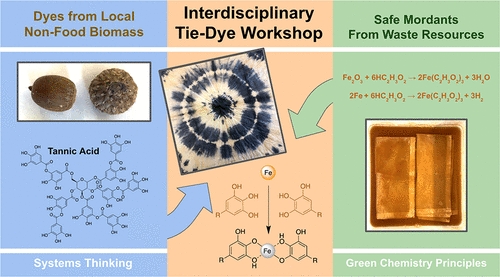博文
如何用橡子和铁锈扎染棉花,使学生将科学、艺术和可持续发展统一起来
 精选
精选
||
如何用橡子和铁锈扎染棉花,
使学生将科学、艺术和可持续发展统一起来
诸平

Tie-dyeing cotton fabric with acorn and rust solutions turns it brown, orange, blue, and black. Credit: Adapted from Journal of Chemical Education 2022, DOI: 10.1021/acs.jchemed.2c00086
据美国化学学会( American Chemical Society)2022年5月29日提供的消息,扎染(Tie-dyeing)是一项有趣的活动,可以为衣服增添色彩,比如T恤上有五颜六色的图案。虽然在商店里可以买到扎染套件,但大自然提供的染料可以从自家后院的东西中提取——比如橡子和铁锈。利用橡子(acorn)和铁锈(rust)溶液扎染棉织物会变成棕色、橙色、蓝色和黑色。相关研究结果于2022年5月12日已经在美国化学学会的《化学教育杂志》(Journal of Chemical Education)网站发表——Christian Machado, Anton O. Oliynyk, Julian R. Silverman. Tie-Dyeing with Foraged Acorns and Rust: A Workshop Connecting Green Chemistry and Environmental Science. Journal of Chemical Education, Publication Date: May 12, 2022. DOI: 10.1021/acs.jchemed.2c00086. https://pubs.acs.org/doi/10.1021/acs.jchemed.2c00086.在此文章中,研究人员提出了一种利用可再生资源和废物处理扎染棉花的“绿色”工艺,本科生可以在最少的监督下轻松完成。这项活动将科学、艺术和可持续发展联系在一起。
参与这项研究的有来自美国曼哈顿学院(Manhattan College)化学与生物化学系(Department of Chemistry and Biochemistry)和环境科学项目组(Environmental Science Program)的研究人员。
几千年来,自然界中发现的材料一直被用作染料(dyes)和媒染剂(mordants),这是帮助将化合物附着在纤维上的物质。橡子中的棕色单宁可以与橙色的铁媒染剂结合,在织物上产生深蓝色,或几乎是黑色。
所以,朱利安·西尔弗曼(Julian Silverman)和同事们想展示这些天然染料如何在扎染中使用,在棉餐巾上产生独特的白色、棕色、橙色和蓝黑色的图案。结果的图案取决于餐巾用橡皮筋包裹的方式,以及它们在橡果染料浴(acorn dye bath)中浸泡、在铁锈和醋溶液中浸泡的顺序。
尽管所有的染色溶液都可以安全地倒进下水道,但研究人员表示,手套、实验室大褂和护目镜可以防止染料染污皮肤或其他衣物。
此研究得到了曼哈顿学院理学院(Manhattan College School of Science)的资助。上述介绍,仅供参考,欲了解更多信息,敬请注意浏览原文或者相关报道。
A two-part workshop connecting environmental science topics and green chemistry principles for undergraduate students is described. Students first collect acorns and rusted metal for dye and mordant baths. After 2 weeks they are invited back to tie-dye cotton fabric using dye baths prepared from steeped acorns and modify these colors using mordant solutions. This workshop allows students to evaluate how using different renewable food or nonfood biomass feedstocks (acorn seeds vs cupules) can create different impacts across chemistry and environmental science. During the workshop, students examine the role of acorns as part of local food systems, and the impacts iron mordants have on fabric dyed with natural tannins, and they design a tie-dye pattern. This activity is well-suited for the fall, when acorns drop from oak trees, and it invites students to come together for interdisciplinary hands-on activities. It serves to highlight green chemistry through the use of renewable and waste feedstocks and uses systems thinking activities to address the potential impacts of selecting different biomass feedstocks. By exploring connections between science and our local environments and the relevance, beauty, and utility of natural renewable chemicals, students from different backgrounds are better able to discuss important connections between green chemistry and environmental science.
https://blog.sciencenet.cn/blog-212210-1341046.html
上一篇:新的疫苗类型克服癌症肿瘤防御
下一篇:美中科学家合作研发的新人工酶可分解坚韧的木质木质素
